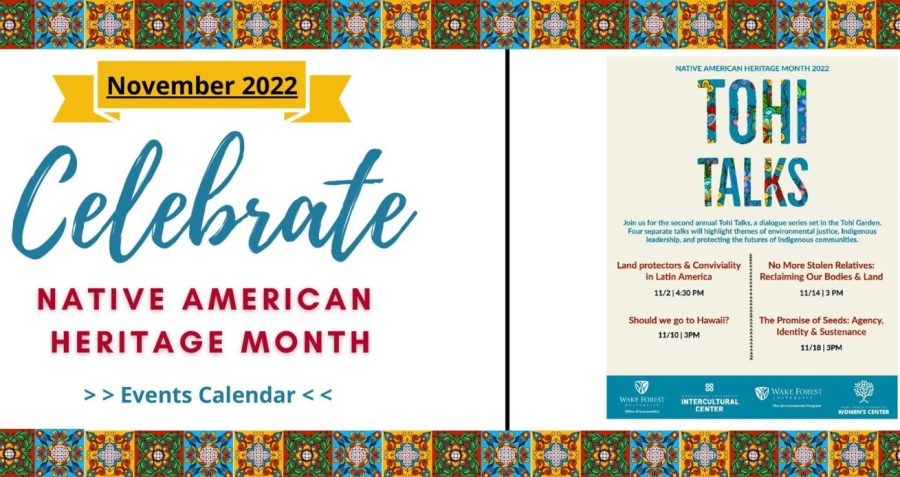Tohi Talk asks: ‘Should we go to Hawaii?’
Many native Hawaiians have asked non-natives to refrain from vacationing on the islands
A Native American Heritage Month flyer shows the “Should We Go to Hawaii” talk.
November 21, 2022
When the average Wake Forest student is prompted to consider the Hawaiian islands, they likely imagine a stunning vacationland ripe with crystal clear waters, surfing and volcanoes. Our thoughts, however, seldom begin with the Indigenous Kānaka Maoli peoples of the islands.
On Thursday, Nov. 10, the Intercultural Center and the Office of Sustainability partnered to host an event at the Tohi Garden that sought to change that association. The discussion, titled “Should We Go to Hawaii?,” was led by Savannah Baber, an assistant director of the Wake Forest University Intercultural Center.
Baber, who is Chickahominy and Lumbee Native American, was inspired by the awareness-raising efforts conducted by Native Hawaiian youth on social media platforms during the peak of the Covid-19 pandemic.
“Seeing what [Native Hawaiian youth] have been able to accomplish in terms of raising awareness and movement building [on social media]… is really interesting and pertinent when thinking about the university and college students,” said Baber.
Many Native Hawaiians became alarmed during the peak of the COVID-19 pandemic when tourists visiting the islands began taxing the healthcare system of a state whose population is around 10% Native Hawaiian, an ethnic group that one University of Hawaii study from 2020 suggests was initially the hardest hit by the pandemic. This prompted youth to take to platforms like TikTok, where they hoped to share their concerns with people around the world.
Online activism during the pandemic opened up a larger conversation about tourism in a state whose history is ripe with the effects of settler colonialism and imperialism.
Hawaii was initially colonized by the British in 1778 and diseases brought by Europeans decimated the Native population in just a few decades. According to Smithsonian Magazine, the Kānaka Maoli population dwindled from 300,000 upon British arrival to 70,000 by 1853. Americans flocked to the islands as well and, by 1893, the United States controlled the Asian immigrant-fueled Hawaiian plantation economy and had overthrown the islands’ monarchy.
Following the bombing of Pearl Harbor in 1941, Hawaii grew in importance as a US territory and, in 1959, became the 50th state. In the years since, Hawaii has been flooded with massive and increasing numbers of tourists; in 2017, nearly 9 million people visited the islands.
In addition to pandemic-fueled fears about human health and safety, tourism on the Hawaiian islands has numerous environmental effects. Aside from undoubtedly massive carbon emissions fueled by aircraft transportation to the islands, tourism also increases microplastics both on and around Hawaii’s beaches.
Over 4,500 miles away from Hawaii, Baber’s talk at the Tohi Garden brought the issue to the forefront of some Wake Forest community members’ minds. As Baber led the discussion, she explained that Native Hawaiians view not only land, but also water, as sacred.
One attendee, sophomore Emory Lewis, mentioned that growing up in coastal Maryland allows her to sympathize with the Kānaka Maoli’s sacred view of not only land but also water. Seeing firsthand the effects of pollution in the waters near her hometown made Lewis aware of the dangers of plastic waste and littering from a young age, something that helps her imagine some of the pain felt by Indigenous Hawaiian communities when tourists litter on and around their sacred waters.
When asked why she came to Baber’s talk, Lewis said she felt as though conversations about Indigenous land issues weren’t happening enough.
“There’s a lot of dialogue that isn’t happening about land,” Lewis said, “…Hawaii is a really interesting case study [when it comes to that] because it is physically removed from the mainland United States and has such a rich history.”
While discussions about land may be foreign to many Wake Forest students, Native Hawaiians are no strangers to fighting to protect their homeland. In addition to activism surrounding tourism, the high-profile controversy that began in 2014 over the construction of the TMT telescope on Mauna Kea concluded in July 2022.
With the history, exploitation, and environmental consequences of Hawaiian tourism in mind, the question remains: should we go to Hawaii?
“I would say that it’s definitely a ripe learning opportunity,” Baber says of the idea of a Wake Forest student visiting Hawaii, “I would hope any student going to Hawaii would use [their visit] as an opportunity to practice the principles of diversity, equity, and inclusion and think about what it means to follow the leadership of Black, brown, and Indigenous people.”















